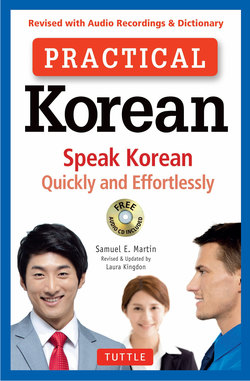Читать книгу Practical Korean - Samuel E. Martin - Страница 12
На сайте Литреса книга снята с продажи.
ОглавлениеLESSON 5
Sentence Structure
English sentences seem to tell you a lot more about a given situation than their equivalents in Korean. That is because the Korean likes to leave out any details that seem obvious from the context or the situation. It’s a rare English sentence that has no subject, but we use such sentences in postcards (Having a fine time. Wish you were here.) and in commands (Keep off the grass. Send more money.). In Korean it is quite common to omit the subject, and often many other parts of the equivalent English sentence, too. You’ll often wonder why the Korean words for some, any, it and other common little English expressions seldom appear in the Korean versions of examples.
A Korean sentence is quite complete with nothing but a verb:
Haeyo.
해요.
(Someone) does (something).
The subject and object may simply be implied. If the Korean wants to supply further details about the situation, he puts them in before the verb. For example, if he wants to tell just what kind of an action the “does” refers to:
Gongbu haeyo.
공부해요.
(Someone) does STUDYING = studies (something).
If it seems important to add the object of the action:
Hangukmal-eul gongbu haeyo.
한국말을 공부해요.
(Someone) studies KOREAN.
And the place:
Hakgyo-eseo Hangukmal-eul gongbu haeyo.
학교에서 한국말을 공부해요.
(Someone) studies Korean IN SCHOOL.
And the time:
Jigeum hakgyo-eseo Hangukmal-eul gongbu haeyo.
지금 학교에서 한국말을 공부해요.
(Someone) studies Korean in school NOW.
And the subject of the action (the actor):
Haksaeng-i jigeum hakgyo-eseo Hangukmal-eul gongbu haeyo.
학생이 지금 학교에서 한국말을 공부해요.
THE STUDENT studies Korean in school now.
The order in which you put the additional information like object, place, time, and subject depends largely on the importance of the information. The indispensable news in every sentence is the verb— this goes at the end.
In other words, if you wanted to say the same thing a little more briefly, you’d likely chop off the earlier parts of the sentence first. Since sometimes the SUBJECT is so well known you don’t have to mention it, but at other times it’s the OBJECT—or the place, or the time, or something else—there isn’t any fixed order. If all other things are equal—that is, if you’re equally in the dark about subject and object— it’s usually better to keep the object near the verb.
